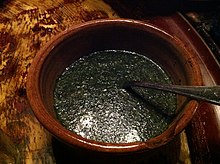
Back ملوخية (طعام) Arabic ملوخيه (اكل) ARZ Sup molokhia BJN Muluchiya German Mulujía Spanish Mulukhiyah Basque ملوخیه Persian Mloukhiya French מלוח'יה HE Sup molokhia ID
This article has multiple issues. Please help improve it or discuss these issues on the talk page. (Learn how and when to remove these messages)
|
 Egyptian molokhiya | |
| Alternative names | molokhiyyah, molokhiyya |
|---|---|
| Type | Soup |
| Course | Side dish |
| Place of origin | Ancient Egypt[1][2] |
| Main ingredients | Jute; beef or chicken stock |
Mulukhiyah (Arabic: ملوخية, romanized: mulūkhiyyah), also known as mulukhiyya , molokhiyya, melokhiyya, or ewédú, is a type of jute plant and a dish made from the leaves of Corchorus olitorius, commonly known in English as jute, jute leaves, jute mallow, nalta jute, or tossa jute.[3][4] It is used as a vegetable and is mainly eaten in Egypt, the Levant (Syria, Lebanon, Palestine, and Jordan), Sudan, Cyprus, Libya, Tunisia and Algeria.[5] It is called saluyot in the Philippines. Mulukhiyah is rather bitter, and when boiled, the resulting liquid is a thick, highly mucilaginous broth; it is often described as "slimy", rather like cooked okra.[6][7]
Mulukhiyah is generally eaten cooked, not raw, and it is either eaten chopped and sautéed in oil, garlic and cilantro like in Syria or turned into a kind of soup or stew like in Egypt, typically bearing the same name as the vegetable in the local language. Traditionally, mulukhiyah is cooked with chicken or at least chicken stock for flavor and is served with white rice, accompanied with lemon or lime. In Tunisia, the dish is prepared with jute powder instead of the leaves and cooked with lamb or beef to be served with bread. In Haiti, a dish prepared from jute leaves is called lalo.
 |
| Part of a series on |
| Arab cuisine |
|---|
- ^ Molokhia – The soup that was once only the privy of the Pharaohs, 2017-06-05
- ^ Christopher Cumo (2013). Encyclopedia of Cultivated Plants: From Acacia to Zinnia [3 Volumes]: From Acacia to Zinnia. Santa Barbara, CA: ABC-CLIO. p. 315. ISBN 978-1-59884-775-8.
- ^ "Corchorus olitorius". Germplasm Resources Information Network. Agricultural Research Service, United States Department of Agriculture. Retrieved 21 April 2016.
- ^ "Corchorus olitorius", New Crop Resource Online Program, Center for New Crops & Plant Products, Purdue University
- ^ "Cypriot Molokhia Recipe". in-cyprus.philenews.com. 21 September 2018. Retrieved 2022-09-21.
- ^ Chittaranjan Kole (24 August 2011). Wild Crop Relatives: Genomic and Breeding Resources: Industrial Crops. Springer Science & Business Media. pp. 54–56. ISBN 978-3-642-21102-7.
- ^ Rough Guides (3 March 2014). Pocket Rough Guide Dubai. Rough Guides Limited. p. 143. ISBN 978-1-4093-7122-9.